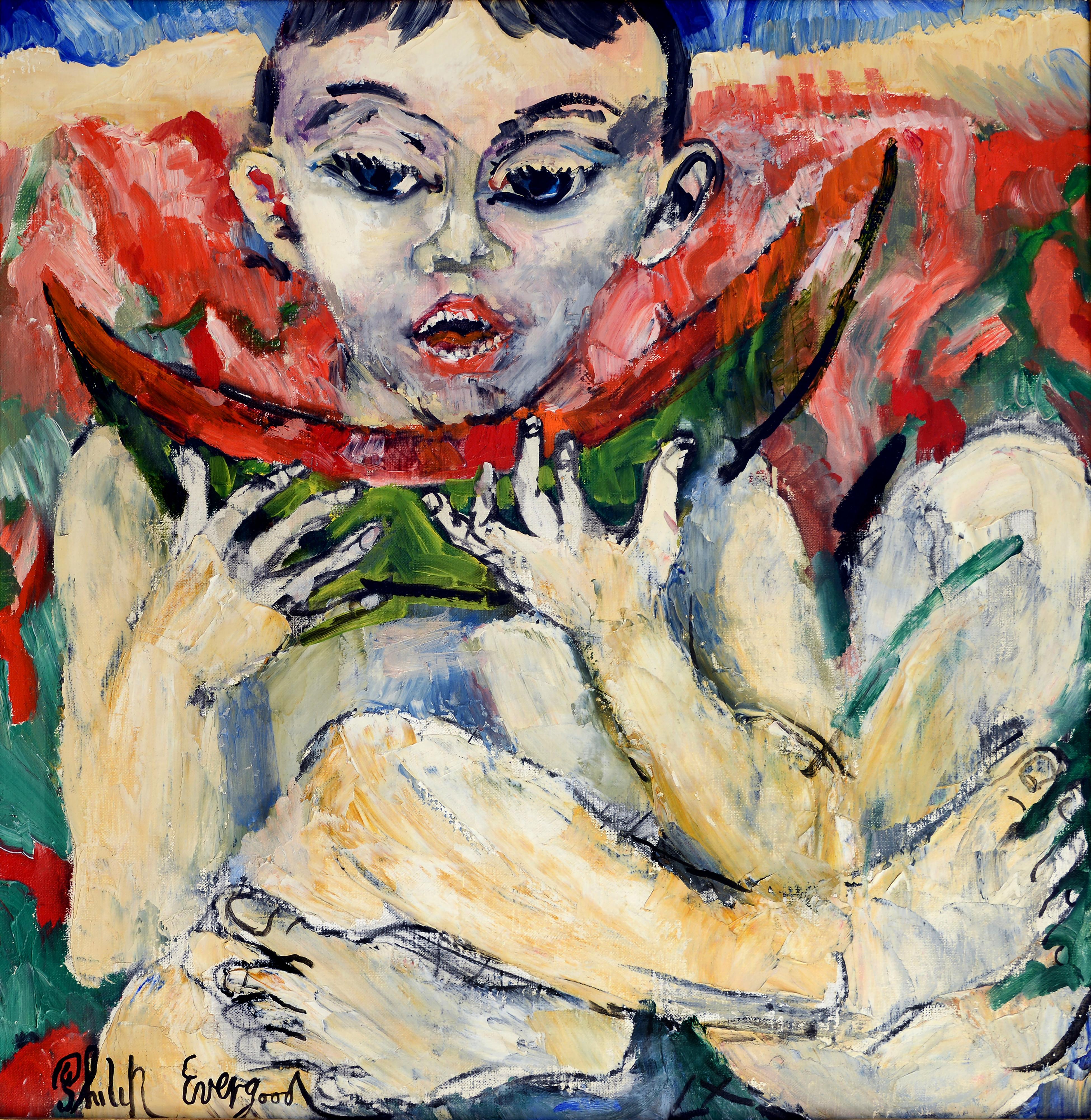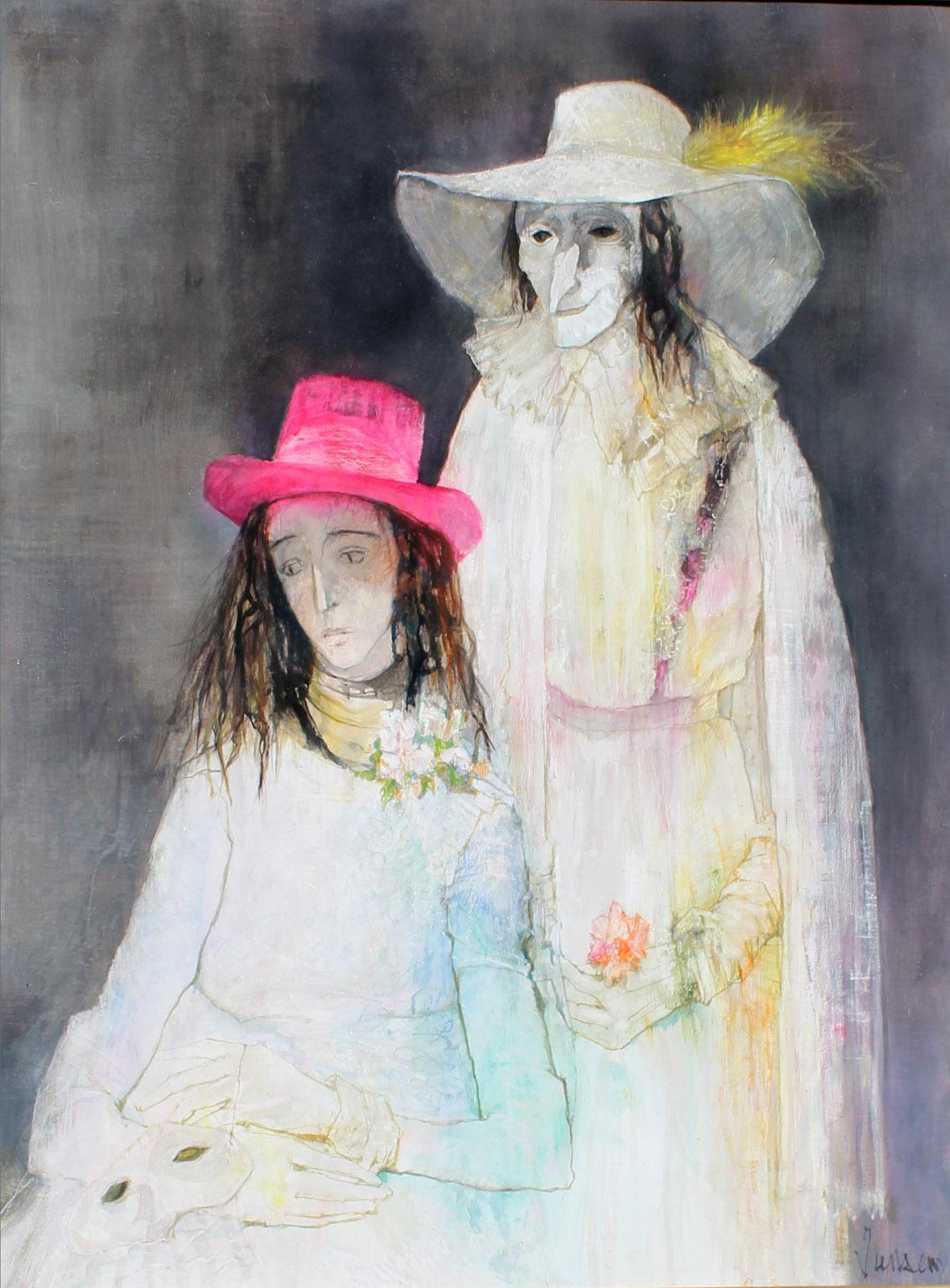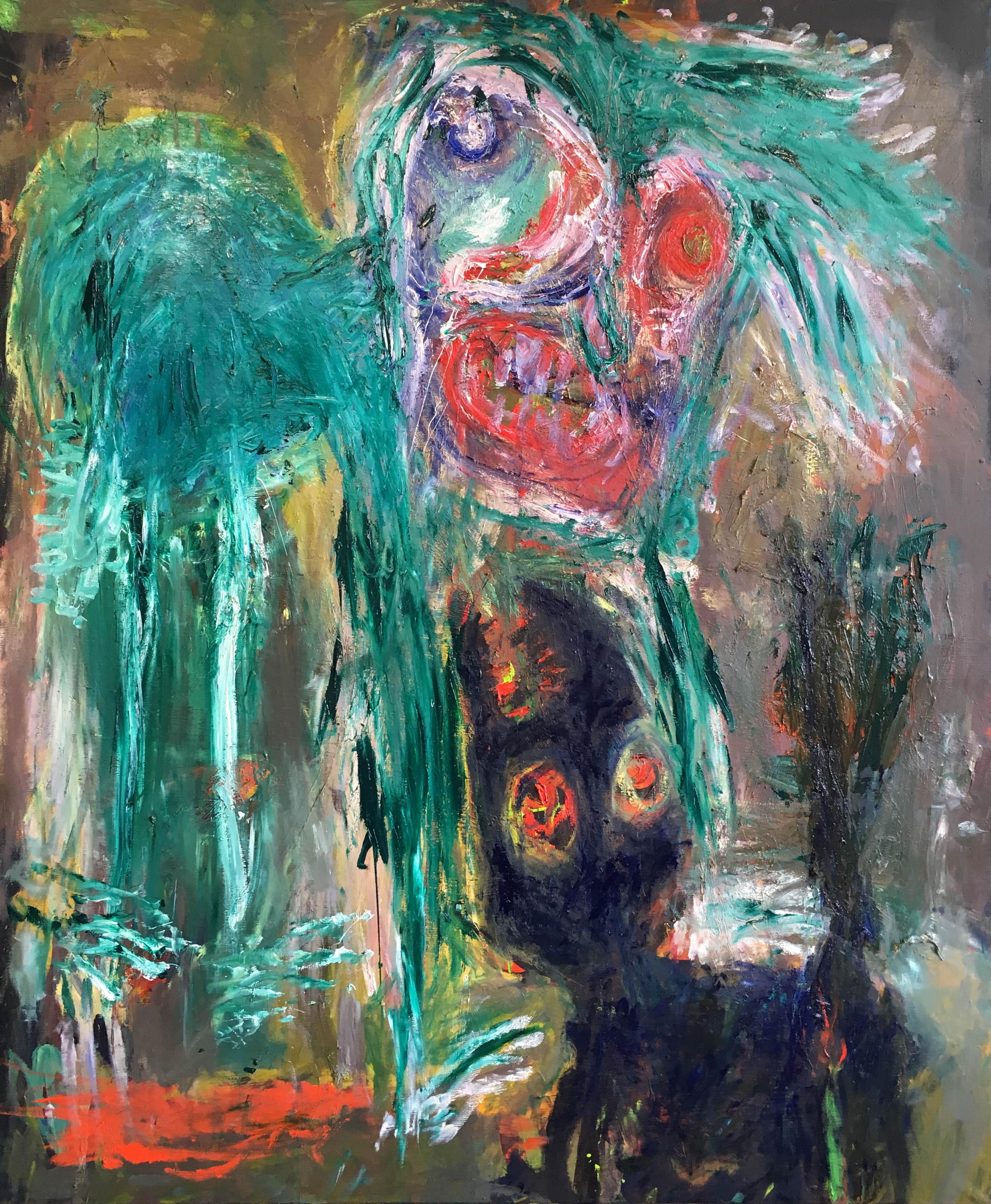Items Similar to Adolf Feder Miniature Oil Painting of a Jewish Rabbi Sensitive Judaica Portrait
Want more images or videos?
Request additional images or videos from the seller
Adolf FederAdolf Feder Miniature Oil Painting of a Jewish Rabbi Sensitive Judaica Portrait
About the Item
Adolphe Aizik Feder (Ukrainian, 1886-1943), alternate spelling Adolf Feder
"Portrait of a Rabbi"
Oil painting mounted to board. Signed (upper left).
Sight size, 6 3/4 by 5 1/8 inches; overall as framed, 8 3/8 by 6 3/4 inches.
Adolphe Féder (1886 – 1943) was a Jewish-Ukrainian painter and illustrator. He moved to France in 1908, where he remained until his deportation and subsequent murder at the hands of the Vichy regime. Adolphe Feder is best-known today for the artwork he produced of those interned with him in the Drancy internment camp.
Born to Jewish Ukrainian merchant parents, in 1905 Féder found himself involved in the revolutionary Bund Labor Movement. His involvement in the organization would force him to flee to Berlin, Germany at the age of 19.
Following his time in Berlin, Féder moved to Geneva, Switzerland before moving to Paris, France in 1908 to study at the Académie Julian. At the Académie he studied painting and worked closely with the French Impressionist, Henri Matisse in his workshop.
In 1926, Féder made a trip to British Mandate Palestine (Israel). On his trip he encountered many Judaic elements, which he painted. The trip's impact on him yielded many of his most notable paintings such as "Juif à barbe tenant un plateau" ("Bearded Jew holding a tray"). When Féder returned to Paris, he brought many of these paintings back with him, which garnered him recognition in the Parisian artistic community.
Before Féder was sent to Auschwitz he painted prisoners and guards in the Drancy internment camp.
When Nazi troops marched across France in 1942, Féder, aged 52, tried to get in contact with the French Resistance but was caught by the Pétain militia. He and his wife were arrested on 10 June 1942 and imprisoned in Cherche-Midi prison; he was transferred to the Drancy internment camp in September 1942. In Drancy, Féder continued to paint, creating portraits of those around him such as the other prisoners and guards. His paintings stopped with his deportation to the Auschwitz concentration camp on 13 December 1943 where he was murdered. Féder's wife, Sima Féder, donated Féder's works from inside Drancy to the Ghetto Fighters' House upon her death in 1967.
Féder's success came in 1912 when his landscape works were displayed at the Salon d'Automne. He continued to paint following this including a series of 45 illustrations created for a book of poetry by French poet Arthur Rimbaud. The book received a limited run of 350 copies in 1924, but was commended for its watercolor illustrations.
When Féder's work appeared in the Fearon Galleries in 1923, his work received great praise. A monograph on Féder was written in 1929 by Gustave Kahn. (also known as Aizik Féder or Айзик Федер)
He was associated with The School of Paris, Ecole de Paris, which was not a single art movement or institution, but refers to the importance of Paris as a center of Western art in the early decades of the 20th century. Between 1900 and 1940 the city drew artists from all over the world and became a centre for artistic activity. School of Paris was used to describe this loose community, particularly of non-French artists, centered in the cafes, salons and shared workspaces and galleries of Montparnasse. Before World War I, a group of expatriates in Paris created art in the styles of Post-Impressionism, Cubism and Fauvism. The group included artists like Pablo Picasso, Marc Chagall, Amedeo Modigliani and Piet Mondrian. Associated French artists included Pierre Bonnard, Henri Matisse, Jean Metzinger and Albert Gleizes.
The term "School of Paris" was used in 1925 by André Warnod to refer to the many foreign-born artists who had migrated to Paris. The term soon gained currency, often as a derogatory label by critics who saw the foreign artists—many of whom were Jewish—as a threat to the purity of French art. Art critic Louis Vauxcelles, noted for coining the terms "Fauvism" and "Cubism", Waldemar George, himself a French Jew, in 1931 lamented that the Ecole de paris, School of Paris name "allows any artist to pretend he is French. it refers to French tradition but instead annihilates it.
The artists working in Paris between World War I and World War II experimented with various styles including Cubism, Orphism, Surrealism and Dada. Foreign and French artists working in Paris included Jean Arp, Joan Miro, Constantin Brancusi, Raoul Dufy, Tsuguharu Foujita, artists from Belarus like Michel Kikoine, Pinchus Kremegne, and Jacques Lipchitz, the Polish artist Marek Szwarc and others such as Russian-born prince Alexis Arapoff.
A significant subset, the Jewish artists, came to be known as the Jewish School of Paris or the School of Montparnasse. The core members were almost all Russian and Polish Jews, and the resentment expressed toward them by French critics in the 1930s was unquestionably fueled by anti-Semitism. Jewish members of the group included Emmanuel Mané-Katz, Chaim Soutine, Adolphe Féder, Chagall, Moïse Kisling, Maxa Nordau and Shimshon Holzman.
The Musée d'Art et d'Histoire du Judaïsme has works from School of Paris artists including Jules Pascin, Michel Kikoine, Chaim Soutine, Chana Orloff and Jacques Lipchitz.
- Creator:Adolf Feder (1886 - 1943, Polish)
- Dimensions:Height: 8.38 in (21.29 cm)Width: 6.75 in (17.15 cm)
- Medium:
- Movement & Style:
- Period:
- Condition:good. frame has wear.
- Gallery Location:Surfside, FL
- Reference Number:1stDibs: LU38210308522
About the Seller
4.9
Platinum Seller
These expertly vetted sellers are 1stDibs' most experienced sellers and are rated highest by our customers.
Established in 1995
1stDibs seller since 2014
1,549 sales on 1stDibs
Typical response time: 1 hour
- ShippingRetrieving quote...Ships From: Surfside, FL
- Return PolicyA return for this item may be initiated within 3 days of delivery.
More From This SellerView All
- Expressionist Judaica French Israeli Modernist Art Oil Painting Rabbi, MusicianBy George ChemecheLocated in Surfside, FLThis is a bright, colorful oil painting of a Hasidic Musician in the the holy city of Jerusalem, Israel 1972, Oil on canvas, 29 X 26 inches Hand signed and dated. George Cheme...Category
1970s Expressionist Figurative Paintings
MaterialsOil
- Large Judaica Oil Painting Samuel Grodensky Hasidic Rabbi, Children in JerusalemLocated in Surfside, FLSamuel Grodensky (1894-1974) "Hassidim" Hand signed and dated "Grodensky '62" u.l., Titled verso in pencil on stretcher 31" x 27" canvas , 35 1/2" x 31 1/2" framed. Large Fauvist Expressionist Jewish Family Oil Painting This is done in an Expressionist style in Fauvist colors. Influenced by the Judaic artists of the early Israeli...Category
1960s Expressionist Figurative Paintings
MaterialsCanvas, Oil
- Large Israeli Expressionist Orientalist Oil Painting Draped Child Kibbutz ArtBy William WeintraubLocated in Surfside, FLWilliam (Sunny) Weintraub, Israeli (Born 1926) Oil on masonite William Weintraub (He was also known as Shlomo Weintraub and nicknamed Sonny Weintraub) Genre: Impressionist Subject: Portrait Medium: Oil Surface: Canvas Dimensions: framed 24 X 32.5 canvas 19 X 27 In an ever-changing art world that embraces one movement after the next, the timeless art of portraiture can become lost. Portraiture is often associated with the royal paintings of centuries-old French kings, European nobility, and other wealthy individuals from art history's past. However, styles like Social Realism and Dutch genre painting spotlighted...Category
Mid-20th Century Expressionist Figurative Paintings
MaterialsCanvas, Oil, Board
- Expressionist Judaica Rabbis Oil Painting Jewish American WPA Modernist Ben ZionBy Ben-Zion WeinmanLocated in Surfside, FLRabbinical Discussion Hand signed lower left. Provenance: bears label verso for Summit Gallery Dimensions: H 14.25" x W 8" Born in 1897, Ben-Zion Weinman celebrated his European Jewish heritage in his visual works as a sculptor, painter, and printmaker. Influenced by Spinoza, Knut Hamsun, and Wladyslaw Reymont, as well as Hebrew literature, Ben-Zion wrote poetry and essays that, like his visual work, attempt to reveal the deep “connection between man and the divine, and between man and earth.” An emigrant from the Ukraine, he came to the US in 1920. He wrote fairy tales and poems in Hebrew under the name Benzion Weinman, but when he began painting he dropped his last name and hyphenated his first, saying an artist needed only one name. Ben-Zion was a founding member of “The Ten: An Independent Group” The Ten” a 1930’s avant-garde group, Painted on anything handy. Ben-Zion often used cabinet doors (panels) in his work. Other members of group included Ilya Bolotowsky, Lee Gatch, Adolph Gottlieb, Louis Harris, Yankel Kufeld, Marcus Rothkowitz (later known as Mark Rothko), Louis Schanker, and Joseph Solman. The Art of “The Ten” was generally described as expressionist, as this style offered the best link between modernism and social art. Their exhibition at the Mercury Gallery in New York held at the same time as the Whitney Annual Exhibition of Contemporary American Painting, included a manifesto concentrating on aesthetic questions and criticisms of the conservative definition of modern art imposed by the Whitney. Ben-Zion’s work was quickly noticed. The New York Sun said he painted “furiously” and called him “the farthest along of the lot.” And the triptych, “The Glory of War,” was described by Art News as “resounding.” By 1939, The Ten disbanded because most of the members found individual galleries to represent their work. Ben-Zion had his first one-man show at the Artist’s Gallery in Greenwich Village and J.B. Neumann, the highly esteemed European art dealer who introduced Paul Klee, (among others) to America, purchased several of Ben-Zion’s drawings. Curt Valentin, another well-known dealer, exhibited groups of his drawings and undertook the printing of four portfolios of etchings, each composed of Ben-Zion’s biblical themes. He worked as a WPA artist. Ben-Zion’s work is represented in many museums throughout the country including the Metropolitan, the Whitney, and the Museum of Modern Art in New York, the Art Institute of Chicago, the Philadelphia Museum of Art and the Phillips Collection, Washington. The Jewish Museum in New York opened in 1948 with a Ben-Zion exhibition. Ben-Zion consistently threaded certain subject matter—nature, still life, the human figure, the Rabbi, the Hebrew Bible, and the Jewish people—into his work throughout his life. "In all his work a profound human feeling remains. Sea and sky, even sheaves of wheat acquire a monolithic beauty and simplicity which delineates the transient as a reflection of the eternal. This sensitive inter- mingling of the physical and metaphysical is one of the most enduring features of Ben-Zion's works." (Excerpt from Stephen Kayser, “Biblical Paintings,” The Jewish Museum Catalogue, 1952). Mystical Imprints: Marc Chagall, Ben-Zion, and Ben Shahn presents the print work of three prominent 20th century Jewish artists born in the Russian Empire. Among these seventy pieces are etchings and lithographs from Chagall’s Bible series...Category
Mid-20th Century Expressionist Figurative Paintings
MaterialsOil, Wood Panel
- Expressionist African American Woman Portrait German Brazilian Harry ElsasLocated in Surfside, FLFramed 20.5 x 18 image 14.5 x 12 Heinz Hugo Erich Elsas, (German-Brazilian 1925-1994) later known as Harry Elsas. Muralist, writer, designer best known as...Category
20th Century Expressionist Figurative Paintings
MaterialsOil, Board
- Modernist Orchestra Musical Gouache Painting Boston ExpressionistBy David AronsonLocated in Surfside, FLVery vibrant, dynamic orchestra scene reminiscent of the work of Mopp (Max Oppenheim) David Aronson, (1923-2015) son of a rabbi, was born in Lithuania in 1923 and immigrated to America at the age of five. He settled in Boston, Massachusetts where he studied at the school of the Museum of Fine Arts under Karl Zerbe, a German painter well known in the early 1900s. Aronson later taught at the school of the Museum of Fine Arts for fourteen years and founded the School of Fine Art at Boston University where he is today a professor emeritus. An internationally renowned sculptor & painter, Aronson has won acclaim for his interpretation of themes from the Hebrew Talmud and Kabala. His best known works include bronze castings, encaustic paintings, and pastels. His work is included in many important public and private collections, and has been shown in several museum retrospectives around the country. He is considered to be one of the most important 20th century American artists. At twenty-two David Aronson had his first one-man show at New York's Niveau Gallery. The next year, six of his Christological paintings were included in the Fourteen Americans exhibition at Manhattan's Museum of Modern Art where Aronson’s work was included alongside abstract expressionists Arshile Gorky, Robert Motherwell and Isamu Noguchi. In the 1950s, Aronson turned more toward his Jewish heritage for the inspiration for his art. Folklore as well as Kabalistic and other transcendental writings influenced his work greatly. The Golem (a legendary figure, brought to life by the Maharal of Prague out of clay to protect the Jewish community during times of persecution) and the Dybbuk (an evil spirit that lodges itself in the soul of a living person until exorcised) frequently appear in his work. In the sixties, Aronson turned to sculpture. His work during this period is best exemplified by a magnificent 8’ x 4’ bronze door which now stands at the entrance to Frank Lloyd Wright's Johnson Foundation Conference Center for the Arts in Racine, Wisconsin. In the seventies and eighties, Aronson continued his work in pastel drawings, paintings, and sculptures, often exploring religion and the frailties of man's nature. During this time, in addition to a traveling retrospective exhibition and many one-man shows in New York, Los Angeles, Chicago, and Boston at the Pucker-Safrai Gallery on Newbury Street, Aronson won many awards and became a member of the National Academy of Design in New York. Two years ago he retired from teaching to work full-time in his studio in Sudbury, Massachusetts. included in the catalog Contemporary Religious Imagery in American Art Catalog for an exhibition held at the Ringling Museum of Art, March 1-31, 1974. Artists represented: David Aronson, Leonard Baskin, Max Beckmann, Hyman Bloom, Fernando Botero, Paul Cadmus, Marvin Cherney, Arthur G. Dove, Philip Evergood, Adolph Gottlieb, Jonah Kinigstein, Rico Lebrun, Jack Levine, Louise Nevelson, Barnett Newman, Abraham Rattner, Ben Shahn, Mark Tobey, Max Weber, William Zorach and others. Selected Awards 1990, Certificate of Merit, National Academy of Design 1976, Purchase Prize, National Academy of Design 1976, Joseph Isidore Gold Medal, National Academy of Design 1976, Purchase Prize in Drawing, Albrecht Art Museum 1975, Isaac N. Maynard Prize for Painting, National Academy of Design 1973, Samuel F. B. Morse Gold Medal, National Academy of Design 1967, Purchase Prize, National Academy of Fine Arts 1967, Adolph and Clara Obrig Prize, National Academy of Design 1963, Gold Medal, Art Directors Club of Philadelphia 1961, 62, 63, Purchase Prize, National Institute of Arts and Letters 1960, John Siimon Guggenheim Fellowship 1958, Grant in Art, National Institute of Arts and Letters 1954, First Prize, Tupperware Annual Art Fund Award 1954, Grand Prize, Third Annual Boston Arts Festival 1953, Second Prize, Second Annual Boston Arts Festival 1952, Grand Prize, First Annual Boston Arts Festival 1946, Traveling Fellowship, School of the Museum of Fine Arts 1946, Purchase Prize, Virginia Museum of Fine Arts 1944, First Popular Prize, Institute of Contemporary Art 1944, First Judge's Prize, Institute of Contemporary Art Selected Public Collections Art Institute of Chicago Virginia Museum of Fine Arts Bryn Mawr College Brandeis University Tupperware Museum, Orlando, Florida DeCordova Museum Museum of Modern Art Print Collection, New York Atlanta University Atlanta Art...Category
20th Century Expressionist Figurative Paintings
MaterialsGouache, Board
You May Also Like
- Untitled, Boy Eating WatermelonBy Philip EvergoodLocated in Miami, FLThe work looks much better in person with snappy bright colors that form a complex abstract composition of interconnected shapes. Hand-signed by artist, sticker label, The Work is Signed lower left - Provenance: Forum Gallery, New York - Label on verso Swann Gallery...Category
1960s Expressionist Portrait Paintings
MaterialsOil
- The Masquerade by Jean JansemBy Jean JansemLocated in La Canada Flintridge, CAThe Masquerade, oil painting signed lower right JANSEM. The painting size is 38"x51" with framed (original frame) size 47"x60". Excellent in condition. From 1934 – 1936 he attended ...Category
1970s Expressionist Figurative Paintings
MaterialsOil
- Coach André Bard - Julien Wolf, 21st Century, Contemporary figurative paintingBy Julien WolfLocated in Paris, FROil on canvas Signed Unique workCategory
2010s Expressionist Figurative Paintings
MaterialsCanvas, Oil
- Supper is not over ! - Julien Wolf, Contemporary Expressionist PaintingBy Julien WolfLocated in Paris, FROil on canvas 2019 Signed Unique work Julien Wolf is a French painter who was born in Strasbourg in 1981, France. In 2007, he graduated and obtained the DNSEP Art and Decorative Art section...Category
2010s Expressionist Figurative Paintings
MaterialsCanvas, Oil
- Isa, Génie, Catou, Patoche and Didine - Julien Wolf, 21st Century, PaintingBy Julien WolfLocated in Paris, FROil on canvas 2018 Signed on the back Unique workCategory
2010s Expressionist Figurative Paintings
MaterialsCanvas, Oil
- Jeremy on acid - Julien Wolf, 21st Century, Contemporary figurative paintingBy Julien WolfLocated in Paris, FROil on canvas Signed Unique workCategory
2010s Expressionist Figurative Paintings
MaterialsCanvas, Oil
Recently Viewed
View AllMore Ways To Browse
Switzerland Portrait
Portrait 19
Louis Portrait
Portrait Of Louis
Surrealism Portrait
Expressionist Oil Portrait
Jewish Studies
Portrait Poet
19 Century Portrait
Portrait 1967
Jewish Oil
Jewish Oil Painting
Miniature Framed Paintings
Russian Portrait Oil
French Painting 1931
Joan Miro Oil
Oil Portrait 1940
Miniature City


